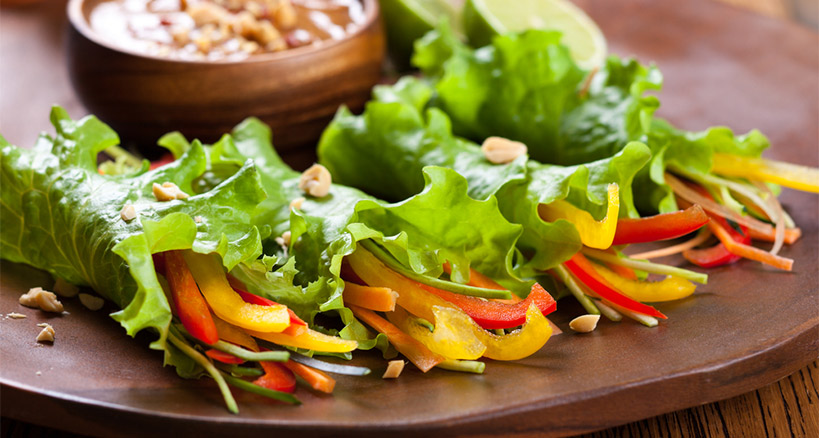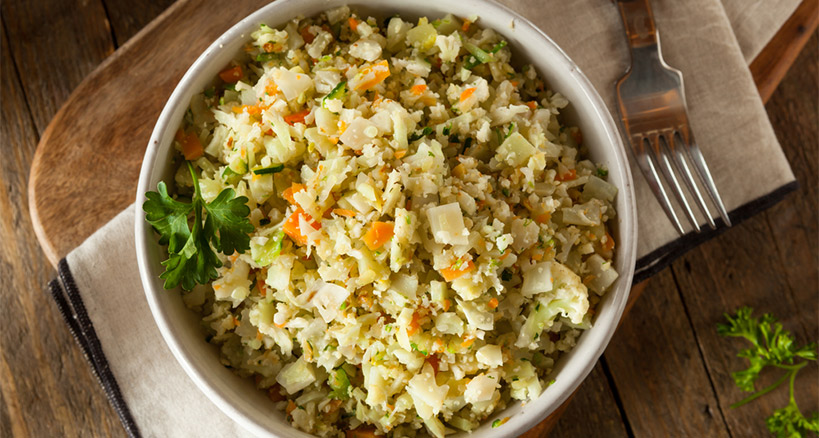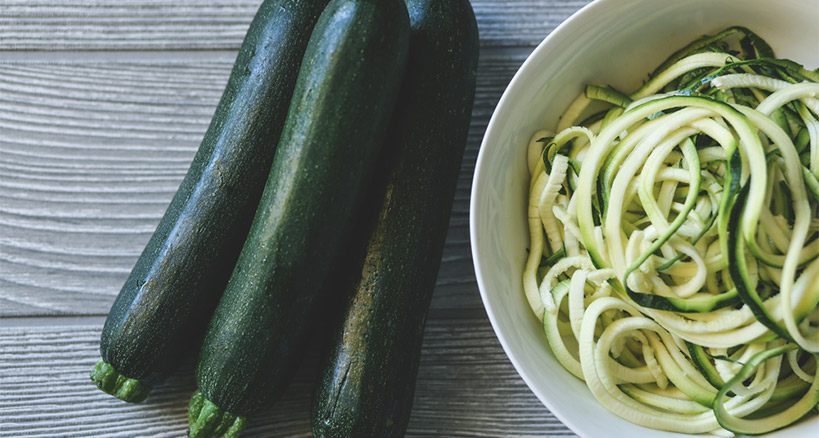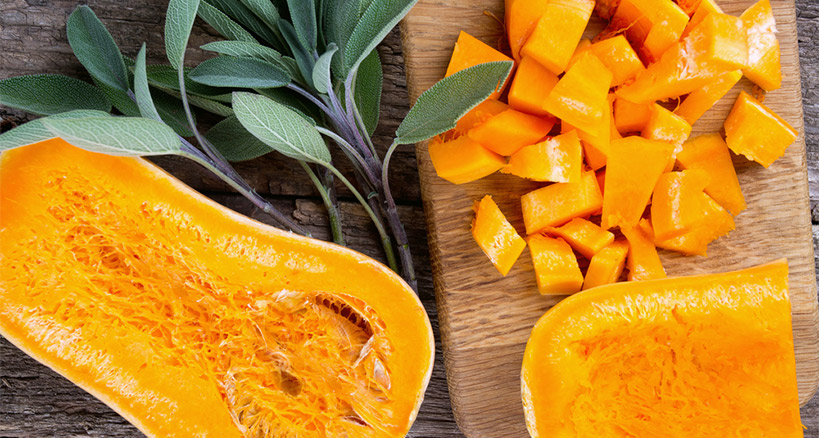
Vegetable Carbohydrate Substitutes
The body’s relationship with carbohydrates is complex – the ultimate love/hate relationship. There’s no question that carbs are important: they give us energy and they contribute to normal brain function. However, not all carbs are good for us, especially not when eaten in large quantities. Many carbs are basic comfort foods – pasta, rice, bread, etc.—and it’s easy to overdo the pleasure of that particular comfort. While some people are ok with cutting out carbs altogether, a better idea may be to eat less of them. Replacing the simple carbs mentioned above with vegetable-based substitutes could be just the solution for adapting a healthier diet.
Why Eat Carbs?
Carbs seem to be everywhere; they’re found in fruits, vegetables, breads, pasta, and dairy products, and they’re an important source of energy. The body uses carbs to make glucose, which is a type of sugar that can be used immediately for energy or stored for later use. “Carbohydrates provide the body with the energy it needs and are a good source of many vitamins and minerals. However, not all carbohydrates are created equal,” says Donna Logan, a registered dietitian at the University of Texas Medical School in Houston.
According to the U.S. Department of Agriculture’s (USDA) Dietary Guidelines for Americans, the best carbs are the ones that contain a lot of fiber, like vegetables, fruits, and whole grains. They take longer to break down into glucose and give you the most nutrients along with your calories. Refined carbohydrates, such as white bread, cookies and cake, are not as good for us; they’ve been processed in order to remove the good part of the grain and they contain added sugar.
Low-Carb Diets and Weight Loss
When we decide to go on a low-carbohydrate diet for weight loss and to take in fewer calories, we will lose weight. The problem is that a low-carbohydrate diet is not a normal balance of nutrition for the human body, so as soon as we start eating carbs again, the weight comes right back. On the other hand, most people can’t live on salad alone; something about carbs causes us to crave them, so other foods – lean proteins and raw vegetables – just seem insubstantial over the long term.
But that’s where creativity comes into play. The idea is to satisfy the craving by using low-carb options to replace calorie-laden carbohydrates. The goal is to find imaginative ways to turn vegetables into substitutes for high-carb foods like pasta, bread, and rice. Without carbs people tend to feel deprived; but with these swaps, no one will feel like they’re missing out, and they’ll get more health benefits at the same time. Veggie substitutes for carbs are lower in calories and higher in nutritional value – a win-win situation, if there ever was one.

The Carb-Vegetable Switcheroo
The National Restaurant Association reports that vegetables are increasingly popular at catered events, particularly for their ability to replace other food items. In fact, for 2018, vegetable-carb substitutes ranked seventh on the list of top 20 food trends. To keep the masses happy, produce companies have developed numerous options to meet the demand for carb-like vegetables, with innovative ideas like riced cauliflower and vegetable noodles, which can be used as alternatives to rice or pasta, but you can make your own just as easily. As a caterer, if you can offer interesting and novel options that play into your customers’ desire to have healthier food options at your events, you’ll find your orders increasing and your business booming. So read on to discover some of the ways you can lower the use of carbs while keeping your guests sated and happy.
Cauliflower Rice (a.k.a. Cauliflower Couscous)
No matter what dish you regularly serve with rice, you can lose the white stuff and substitute it with cauliflower – a healthy low-carb alternative. Low in fat and carbs, cauliflower is packed full of dietary fiber and vitamin C, making it one of the most versatile vegetables around. Made correctly, cauliflower rice is surprisingly grain-like; it’s light and fluffy, like couscous, and has just the right amount of tenderness and chewiness, like rice.
To make cauliflower rice/couscous, pulse the raw cauliflower florets in a food processor or grate them on a box grater, until they’ve broken down into small – tiny – granules. Eaten raw, the grains are tender but crunchy with a mild flavor, and they can be used like cooked grains in salads such as tabbouleh or any lunch salad. Quickly sauté them in a little butter or olive oil on the stovetop and the “rice” becomes softer and more tender and it can easily be served like rice as a side dish for curries or stir-fries, or as a filling for burritos.

Zoodles
Pasta – versatile and filling – is a great food. With just a simple sauce, you can turn pasta into a gourmet meal that your customers will love you for… all except the customers who are looking to cut back on carbs. So, for clients who want the “pasta experience” but also want to avoid gluten and pasta, turn to the simple zucchini for help.
Zucchini noodles – zoodles – outdo even spaghetti starch as a long pasta (spaghetti, fettucine, etc.) substitute. You can mix them with your signature tomato sauce, and your health-conscious guests will enjoy your effort to meet them more than halfway.
Easy Zoodles
Ingredients
- 2 zucchinis, peeled
- 1 tablespoon olive oil
- 1/4 cup water
- Salt and ground black pepper to taste
Directions
- Peel lengthwise slices from the zucchini using a vegetable peeler, stopping when the seeds are reached. Turn zucchini over and continue peeling until all the zucchini is in long strips; discard seeds.
- Slice the zucchini into thinner strips resembling spaghetti.
- Heat olive oil in a skillet over medium heat; cook and stir zucchini in the hot oil for 1 minute.
- Add water and cook until zucchini is softened, 5 to 7 minutes.
- Season with salt and pepper.
Another option for creating zucchini noodles is to use a spiralizer — and if you plan on making zoodles an important part of your healthy menu, then it’s a small investment that will go a long way. However, using a julienne peeler is a good option as well – it’s cheaper and much smaller than a spiralizer — so if you’re strapped for either money or space (or both!) go for the less expensive and more compact item.

Butternut Squash Fries
Arguably the most addictive and delicious carb in the world is the French fry. Loved by kids and adults alike, French fries are irresistible to almost anyone except those with the strongest willpower. Why resist? Because fries are extremely high in carbohydrates and loaded with fat, as well. So how can you help your fry-loving clients who are also trying to stay virtuous? Delicious homemade savory-sweet butternut squash fries to the rescue!
Butternut squash fries taste like sweet potato fries and, better yet, they don’t have to be fried to be delicious. All you need to create this great low-carb, low-starch alternative to French fries is a good knife and some ingenuity. Slice the squash as thick or thin as you like and dust the slices with seasoning, such as rosemary, pepper, or smoked or sweet paprika. Lay the slices on a baking pan lined with parchment paper, give the slices a light spray of olive oil, and bake in the oven until done. Make a few batches – your guests will eat them up faster than you can bring them out!
No-Carb Wraps
Wraps are huge these days at catered events; they can be filled with anything from guacamole to tuna salad to sandwich meat, and, when arranged nicely, they are easy on the eyes, as well. Wraps, especially whole wheat wraps, are somewhat healthful; however, if your clients are looking to cut down on starches, try carb-less wraps and impress them with your ingenuity.
With no-carb wraps, large leafy greens, such as cabbage or a good sized piece of lettuce, stand in for the usual corn or wheat tortilla that are usually filled and rolled to create wraps. You don’t have to cook the greens, as the crunchy texture adds to the overall appeal. Any filling that you’d ordinarily use for a tortilla wrap can be used in a veggie wrap. You’ve kept the appeal and allure of the versatile wrap, while leaving the carbs for another occasion.
Vegetables Trump Carbs
These days, caterers must scramble to come up with great ideas that keep them abreast of the current requests for healthy foods at catered events. Although there’s no escaping the fact that carbs are filling and delicious – and perhaps the basis of some of your signature dishes – it’s time to use vegetables in ways that you may never have thought of before. Let cauliflower, zucchini, butternut squash and other versatile vegetables stand in for the carbs at your next event. You and your clients will be glad that you did.